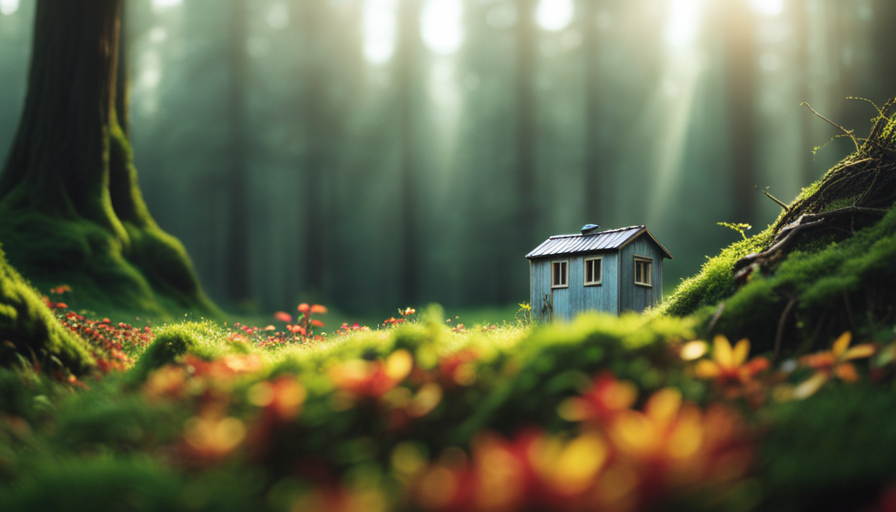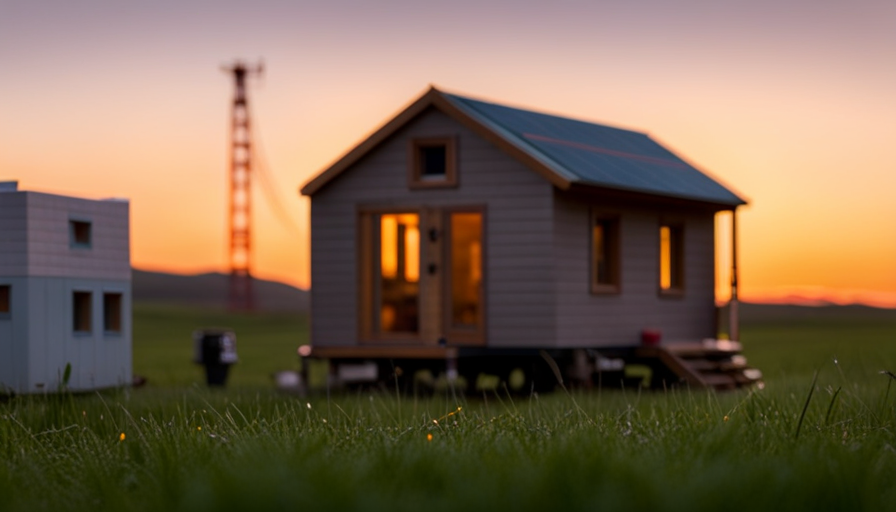Sometimes, unexpected events lead us down paths we never could have imagined, shaping the course of our lives in ways we never thought possible. My interest in a non-traditional way of living was sparked by a chance encounter with a small home. Intrigued by the idea of simplifying and decluttering, I decided to investigate how long people really live a tiny house lifestyle.
Through extensive research and interviews with tiny house residents, I discovered a world filled with both challenges and rewards. From the benefits of minimalism and the sense of community in tiny house villages, to the struggles of adjusting to a smaller space and the complexities of living with a family, the reality of tiny house living is far from romanticized.
In this article, we will explore the various aspects of tiny house living, examining the factors that contribute to long-term happiness and satisfaction. Personal stories from those who have embraced this lifestyle will shed light on the realities of living in a tiny house, offering valuable insights for those considering making the transition.
Join me on this journey as we delve into the world of tiny houses and uncover the secrets of those who have chosen to call them home.
Key Takeaways
- Coincidences can lead to unexpected paths, shaping lives in unimaginable ways.
- Benefits of living in a tiny house include financial savings, minimalistic lifestyle, and sustainability.
- Challenges of tiny house living include limited space, privacy concerns, lack of storage, and zoning issues.
- Designing a tiny house allows customization and fosters a sense of community in tiny house villages.
Benefits of Living in a Tiny House
Living in a tiny house brings a multitude of benefits that make it a truly enjoyable and fulfilling experience. One of the primary advantages of downsizing to a tiny house is the financial savings it offers. With lower construction and maintenance costs, as well as reduced utility bills, tiny house living can significantly lighten the financial burden.
Moreover, the minimalistic lifestyle that comes with living in a tiny house encourages people to prioritize their spending and focus on what truly matters, leading to increased financial freedom and stability.
Aside from the financial benefits, downsizing to a tiny house also promotes a simpler and more sustainable lifestyle. The limited space forces individuals to declutter and rid themselves of unnecessary possessions, leading to a more organized and stress-free living environment. Additionally, the reduced energy consumption and carbon footprint associated with tiny house living contribute to a more eco-friendly lifestyle, which is increasingly important in our current environmental crisis.
Living in a tiny house offers a range of benefits, including financial savings and a simpler, more sustainable lifestyle. However, it’s important to acknowledge that this lifestyle is not without its challenges. Transitioning to a smaller space and adapting to a minimalist lifestyle requires careful planning and adjustment. Nonetheless, with the right mindset and approach, the rewards of tiny house living far outweigh the challenges.
Overcoming Challenges of Tiny House Living
Embrace the challenges of tiny house living and discover creative solutions to overcome them. Living in a tiny house certainly has its challenges, but with the right mindset and a bit of resourcefulness, these challenges can be conquered.
Here are some common challenges faced by tiny house dwellers and the solutions they have found:
-
Limited Space: The lack of square footage can be daunting, but by adopting a minimalist lifestyle and utilizing clever storage solutions such as hidden compartments and multi-functional furniture, every inch of space can be maximized.
-
Privacy Concerns: Privacy can be a challenge in a tiny house, especially if you have visitors or live with a partner. Installing curtains, using room dividers, or incorporating sliding doors can help create separate spaces within the tiny house, ensuring everyone has their own personal space.
-
Lack of Storage: With limited storage options, it’s important to get creative. Building shelves and cabinets on vertical walls, utilizing under-bed storage, and using hooks and hanging organizers can make a huge difference in keeping your tiny house organized and clutter-free.
-
Zoning and Legal Issues: Tiny houses often face zoning and legal restrictions. To overcome these challenges, it is crucial to research local regulations, obtain necessary permits, and join tiny house communities for support and guidance.
By finding solutions to these challenges, living in a tiny house becomes more manageable and enjoyable. Now, let’s explore the exciting process of building and designing your dream tiny house.
Building and Designing Your Dream Tiny House
Building and designing your dream tiny house is an exciting journey filled with endless possibilities and creative solutions. It allows you to customize your living space according to your needs and preferences. However, it also comes with its fair share of challenges. Designing a tiny house requires careful consideration of space utilization and functionality. The limited square footage means that every inch counts, and finding innovative storage solutions becomes essential. Additionally, designing a tiny house that is sustainable and eco-friendly adds another layer of complexity. Incorporating renewable energy sources, efficient insulation, and water-saving features are just a few of the challenges that need to be overcome.
To provide a visual representation of the design challenges faced in tiny house living, the following table showcases common design considerations and possible solutions:
| Design Challenge | Possible Solution |
|---|---|
| Limited Space | Multi-functional furniture |
| Storage | Built-in shelving units |
| Privacy | Sliding doors |
| Lighting and Ventilation | Skylights and windows |
Despite the challenges, designing a tiny house allows you to create a space that reflects your personality and values. It also offers the opportunity to be part of sustainable communities where like-minded individuals come together to support each other. These communities foster a sense of belonging and shared values, making tiny house living a fulfilling and enriching experience.
[Transition Sentence] Building and designing your dream tiny house is just the first step towards creating a sense of community in tiny house villages.Creating a Sense of Community in Tiny House Villages
Imagine yourself walking through a vibrant and close-knit neighborhood, where each tiny house is nestled amongst lush greenery, creating a sense of community in the tranquil setting of a tiny house village. Community engagement and social connections play a crucial role in the success and longevity of living in a tiny house.
Research has shown that individuals who actively engage with their neighbors and participate in community activities are more likely to stay in their tiny homes for an extended period. By fostering a strong sense of community, residents can find support, friendship, and a sense of belonging within their village.
Community engagement in tiny house villages can take various forms. Regular community events such as potluck dinners, game nights, or gardening clubs provide opportunities for residents to come together, socialize, and form meaningful connections. These activities not only enhance the overall well-being of individuals but also create a support system within the community, making it easier for residents to adapt to the minimalist lifestyle.
Transitioning into the subsequent section about adjusting to a minimalist lifestyle, it is important to understand the impact of social connections on this process.
Adjusting to a Minimalist Lifestyle
Transitioning into a minimalist lifestyle can be a challenge, as individuals may need to let go of material possessions and prioritize experiences and relationships over material wealth. Embracing simplicity is at the core of this lifestyle, where the focus shifts from accumulating things to finding contentment in what one already has.
Living in a tiny house naturally encourages a minimalist mindset, as the limited space necessitates careful consideration of every item brought into the home.
Embracing a minimalist lifestyle involves making intentional choices about what to keep and what to let go of. It requires a shift in mindset from consumerism to contentment. Research has shown that simplifying one’s life can lead to increased happiness and well-being. By reducing clutter and excess, individuals can create a more peaceful and organized living environment.
Adjusting to a minimalist lifestyle also means reevaluating one’s priorities. Instead of spending money on material possessions, individuals may choose to invest in experiences and relationships. This shift can lead to a greater sense of fulfillment and connection with others.
Transitioning to a minimalist lifestyle is an ongoing process. It requires practice and commitment to continually evaluate and reevaluate one’s possessions and priorities. By embracing simplicity, individuals can create a more intentional and fulfilling life.
In the subsequent section about long-term sustainability and maintenance, we will explore the challenges and benefits of living in a tiny house over an extended period of time.
Long-Term Sustainability and Maintenance
When it comes to long-term sustainability and maintenance of a tiny house, there are several key points to consider.
First and foremost, ensuring the structural integrity of the house is crucial to its longevity. This includes regular inspections and maintenance to address any potential issues.
Additionally, regular upkeep is necessary to keep the house in good condition, such as cleaning, repairing any damages, and updating the interior as needed.
Lastly, adapting to changing needs and life stages is important as the occupants may require different amenities or space configurations over time.
Ensuring Structural Integrity
To ensure the structural integrity of your tiny house, it’s essential to regularly inspect and maintain its foundation, walls, and roof. Ensuring safety and compliance with construction regulations is crucial when building and living in a tiny house. Regular inspections should be conducted to identify any potential issues and address them promptly. This includes checking for cracks or shifts in the foundation, inspecting the walls for signs of moisture or structural damage, and examining the roof for leaks or damage. By maintaining a proactive approach to structural maintenance, you can prevent larger issues from arising and ensure the long-term sustainability of your tiny house. Transitioning into the subsequent section about regular maintenance and upkeep, it is important to establish a routine schedule to maintain the overall functionality and appearance of your tiny house.
Regular Maintenance and Upkeep
When it comes to living in a tiny house, ensuring structural integrity is crucial. However, it’s not enough to just build a solid foundation and sturdy walls. Regular maintenance and upkeep are essential to ensure the longevity of a tiny house.
This includes addressing any issues that may arise and taking proactive measures to prevent future problems. Maintaining a tiny house can be a cost-effective endeavor, but it does require some financial investment. From routine tasks like cleaning and painting to more complex repairs like fixing plumbing or electrical systems, the cost of maintenance can add up over time.
Common maintenance issues in tiny houses include dealing with moisture and ventilation, managing limited storage space, and handling pests. It’s important to stay vigilant and address these issues promptly to avoid further damage or inconvenience.
Transitioning into the subsequent section about ‘adapting to changing needs and life stages,’ it is crucial to acknowledge that living in a tiny house requires continuous adaptation and flexibility.
Adapting to Changing Needs and Life Stages
Adapting to changing needs and life stages in a tiny house requires constant flexibility and a willingness to adjust your living space accordingly. As people transition into retirement, their needs and preferences may change. They may require more accessibility features, such as ramps or wider doorways, to accommodate potential mobility issues. Additionally, they may want to downsize their belongings and create a more minimalist living environment.
On the other hand, tiny houses can also cater to growing families. With clever space-saving solutions, such as loft beds or convertible furniture, tiny houses can provide enough room for a family to live comfortably. It may require creative thinking and efficient use of space, but it is possible to adapt a tiny house to meet the changing needs of different life stages. This flexibility is what makes tiny house living a viable option for a variety of individuals and families.
Transitioning to the next section, let’s explore how tiny houses can accommodate the needs of families.
Tiny House Living with a Family
Living in a tiny house with your family can be a long-term commitment, with statistics showing that over 60% of families who move into a tiny house plan to stay for at least 5 years. This decision requires careful consideration of various factors, including family dynamics and space management.
Here are some key strategies that families use to make tiny house living work:
-
Maximizing storage: Utilizing creative storage solutions such as built-in shelves, under-bed storage, and multi-purpose furniture helps families optimize their limited space.
-
Establishing designated areas: Designating specific areas for different activities, such as a homework corner or play area, helps maintain a sense of order and functionality within the tiny house.
-
Creating outdoor living spaces: Families often prioritize outdoor living spaces, such as patios or gardens, to provide additional room for relaxation and play.
-
Implementing routines and schedules: Establishing routines and schedules helps families manage their time efficiently and ensure everyone’s needs are met within the limited space.
-
Open communication and compromise: Maintaining open lines of communication and being willing to compromise are essential for resolving conflicts and finding solutions that work for everyone.
These strategies, combined with the adaptability and resilience of families, contribute to the success of tiny house living. Personal stories of tiny house residents further demonstrate the unique experiences and challenges faced by individuals and families in their pursuit of a minimalist lifestyle.
Personal Stories of Tiny House Residents
Imagine hearing firsthand accounts from individuals who’ve embraced the minimalist lifestyle and made the courageous decision to call a tiny house their home. These personal stories shed light on the challenges and benefits of living in such a small space.
Living in a tiny house comes with its fair share of personal challenges. Limited space means having to downsize belongings and adapt to a simpler way of life. Many residents have to be creative in finding storage solutions and make careful decisions about what items are essential.
Additionally, living in close quarters with family members can sometimes lead to conflicts and a lack of privacy. However, these challenges often result in personal growth and a greater appreciation for the things that truly matter.
Despite the challenges, there are many unexpected benefits to living in a tiny house. The financial freedom that comes with reduced living expenses allows residents to pursue their passions, travel, or save for the future. The simplicity of tiny house living also fosters a sense of mindfulness and intentionality. Residents often report feeling more connected to nature and their surroundings, as their small space encourages them to spend more time outdoors.
Transitioning to tiny house living requires careful planning and a willingness to embrace a minimalist lifestyle. However, the personal challenges and unexpected benefits make it a worthwhile endeavor.
Making the Transition to Tiny House Living
Ready to downsize and embrace a minimalist lifestyle? Making the transition to tiny house living means embracing simplicity and finding creative solutions for your new space. However, this transition comes with its own set of challenges.
One of the main challenges is adjusting to the limited space available in a tiny house. It requires careful planning and organization to maximize every square inch. Additionally, you might need to let go of some belongings that you no longer need or have space for. This can be emotionally difficult for some people, but it’s an essential part of the transition process.
Another significant consideration when transitioning to tiny house living is the financial aspect. While tiny houses can be more affordable than traditional homes, there are still costs involved in building or buying one. You need to carefully assess your budget and determine if you can afford the initial investment. Additionally, ongoing expenses such as utilities, maintenance, and insurance should be taken into account.
Transitioning to tiny house living requires both practical and financial considerations. It’s important to weigh the benefits and challenges before making the leap. However, once you’ve successfully made the transition, the rewards can be immense.
In the subsequent section, we’ll explore the long-term happiness and satisfaction that people experience in their tiny house lifestyle.
Long-Term Happiness and Satisfaction in Tiny House Living
Embrace the euphoria and elation of everlasting contentment in your tiny haven. When it comes to long-term happiness and satisfaction in tiny house living, there are important factors to consider.
One of the key aspects is the long-term financial implications. Living in a tiny house can significantly reduce expenses such as mortgage payments, utility bills, and maintenance costs. With fewer financial burdens, individuals can experience a sense of freedom and peace of mind, which contributes to their overall happiness.
However, it is essential to acknowledge the psychological effects that come with living in a tiny house in the long run. While some people thrive in the simplicity and minimalism, others may struggle with the limited space and lack of privacy. It is crucial to assess one’s personality and preferences before making the transition to tiny house living. Additionally, the ability to adapt and make the most out of the available space plays a vital role in long-term satisfaction.
Research has shown that individuals who successfully adjust to tiny house living and embrace the lifestyle tend to experience higher levels of contentment and fulfillment. They often value experiences over material possessions and find joy in the freedom that comes with living with less. However, those who struggle with the constraints of tiny house living may find themselves longing for more space and amenities.
Long-term happiness and satisfaction in tiny house living are influenced by both the long-term financial implications and the individual’s ability to adapt and find contentment within limited space. By carefully considering these factors, one can make an informed decision and create a fulfilling and sustainable tiny house lifestyle.
Frequently Asked Questions
Are there any financial incentives or tax benefits to living in a tiny house?
There are indeed financial incentives and tax benefits to living in a tiny house. By embracing a minimalist lifestyle and reducing living expenses, individuals can save money on maintenance, utilities, and property taxes.
Additionally, some states offer tax incentives for homeowners who choose to live in tiny houses, such as lower property tax rates or exemptions. These financial advantages make tiny house living an attractive option for those seeking to maximize their savings and minimize their expenses.
What are the potential health and safety concerns associated with tiny house living?
Living in a tiny house may seem charming, but it comes with potential health concerns and safety risks. Limited space can lead to poor air quality and increased risk of mold growth, causing respiratory issues.
Additionally, cramped living conditions can result in accidents and injuries. Safety hazards like steep ladders or narrow staircases pose a threat, especially for older individuals or those with mobility issues.
It’s crucial to consider these factors before embarking on a tiny house lifestyle.
How do you handle privacy and personal space in a tiny house?
Privacy challenges and maximizing space are key considerations in handling personal space in a tiny house. Limited square footage can lead to a lack of privacy, as there are often no separate rooms. However, creative design solutions can help address this issue.
Utilizing curtains, folding screens, or built-in shelving can create separate areas within the tiny house. Additionally, incorporating storage solutions that maximize vertical space can help maintain an organized and clutter-free living environment, further enhancing privacy and personal space.
Can you customize and personalize a tiny house to fit your individual needs and preferences?
Customization options in tiny houses are limited due to space constraints. However, it’s possible to personalize a tiny house to some extent. Clever storage solutions, multipurpose furniture, and creative design can help maximize space and cater to individual needs.
While customization may be challenging, it’s essential for creating a comfortable living environment. Although it’s unclear how long people stick with living in a tiny house, having the ability to personalize and customize their space may enhance their overall experience and satisfaction.
How do you deal with the limited storage space in a tiny house?
When it comes to dealing with limited storage space in a tiny house, maximizing functionality and creative organization are key.
By utilizing multi-purpose furniture, such as beds with built-in storage or foldable tables, one can optimize the available space.
Additionally, utilizing vertical storage solutions, such as wall-mounted shelves or hanging organizers, can help make the most of limited floor space.
With careful planning and strategic organization, the limited storage space in a tiny house can be effectively managed.
Conclusion
In conclusion, after thoroughly examining the benefits and challenges of living in a tiny house, it becomes clear that the decision to embrace this lifestyle is not one to be taken lightly.
Like a delicate flower, tiny house living requires nurturing and care to ensure its long-term survival. However, for those who are willing to put in the effort, the rewards can be immense.
The sense of community, the freedom from excess, and the satisfaction of consciously choosing simplicity can lead to long-term happiness and fulfillment.
So, if you’re ready to embark on this unique journey, remember to tend to your tiny house with love and watch it flourish.
Hi, I’m Emma. I’m the Editor in Chief of Tiny House 43, a blog all about tiny houses. While tree houses are often associated with childhood, they can be the perfect adult retreat. They offer a cozy space to relax and unwind, surrounded by nature. And since they’re typically built on stilts or raised platforms, they offer stunning views that traditional homes simply can’t match. If you’re looking for a unique and romantic getaway, a tree house tiny house might just be the perfect option.










